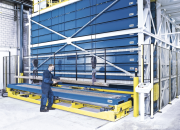 In times of increasing competition the need to rationalise processes in the area of intralogistics is under constant scrutiny. Investing in automated storage systems can bring about the desired increase in productivity and purchasing software-controlled storage lifts saves money in some key warehouse areas and relieves cost pressures on the segment, including costs attributable to the following:
In times of increasing competition the need to rationalise processes in the area of intralogistics is under constant scrutiny. Investing in automated storage systems can bring about the desired increase in productivity and purchasing software-controlled storage lifts saves money in some key warehouse areas and relieves cost pressures on the segment, including costs attributable to the following:
- Labour costs
- Building costs
- Picking costs
- Illness related costs
- Costs due to picking errors
1.Reducing labour costs
- Investing in systems that work in line with the goods-to-person principle reduces unnecessary journeys undertaken by warehouse employees and thus speeds up the operation.
- In addition, optical signals or displays (pick-to-light systems) integrated into the units assist the employees by providing information on the location of the items and the number to pick.
- Individual orders are also picked in batches, which also speeds up the operation.
When combined, these three methods significantly optimise manpower and increase productivity by anything between 200 and 600 percent. Furthermore, new technology means that fewer employees are needed to process more orders. As such, the remaining employees can be given other jobs in the warehouse or other positions within the company.

2. Reducing space costs
Thanks to their modular design vertical lift systems can be precisely adapted to fit the available height in the warehouse. They can be built much taller than conventional shelving and also save space that would normally be reserved for aisles along which employees and transport carts move. This principle makes it possible to reduce the amount of storage space needed by up to 85 percent.
Furthermore, special compartments and shelves can be fitted to the trays with the storage systems to accommodate the greatest number of items, thereby reducing the amount of storage space for each item. It means that it is no longer necessary to move to larger premises due to a need for extra storage space.
3. Reducing picking costs
Incoming orders are arranged and cleared for processing using software. In the process, individual lines from the various orders are consolidated. If, for instance, a certain item has been requested in several orders, the individual lines are put together and the item is retrieved from the storage system just once in a batch. Each of these items is later added to the individual orders from a buffer storage system located at a workstation. This batch picking method significantly increases the number of orders that can be processed, because the process of searching for, retrieving, and picking up the items is performed automatically and just once.
This means that production or customer orders can be fulfilled much more quickly, which not only helps to reduce costs as a result of the time saved, but also increases satisfaction in downstream areas as a result of the faster processing and dispatch times.

4. Reducing illness-related costs
There is a real emphasis on ergonomics in the workplace with dynamic retrieval systems. The goods-to-person principle on which they work not only saves employees the laborious task of traveling around the warehouse – it is not unusual for employees to cover a distance of fifteen kilometres in a single shift with conventional storage solutions.
What’s more, the items are conveyed directly to the workstation via the units’ access openings at hip height, which is ergonomically beneficial. Bending and stretching motions, which can cause injury, especially with heavy items, are thus no longer necessary, thereby preventing one of the main causes of incapacity to work: injuries or signs of wear to the musculoskeletal system. These measures thus cut illness-related costs attributable to missing employees and also reduce insurance premiums for occupational safety benefits.

5. Reducing costs due to picking errors end up being twice as expensive. For one thing, there are the costs associated with picking and dispatching the incorrect intact article. However, there are costs associated with reintegrating the incorrect item and repacking the correct one. Online retailers will also have to pay for the item to be returned and there may also be costs for checking, cleaning and resending the goods. All in all, costs are accumulated which have a highly negative effect on productivity considering the comparatively high error rate associated with conventional storage solutions.
In contrast, software-controlled storage and retrieval systems achieve picking accuracy rates of almost one hundred percent. Clever warehouse management software makes this possible while also eliminating the natural mistakes made by employees. The result of this is that the company saves money with every picking error that is avoided.
In view of the many advantages outlined in relation to costs and efficiency, the return on investment is achieved on average after just one or two year across a wide range of industries.
For more information contact Kardex Remstar www.kardex-remstar.co.uk or contact us direct at info.remstar.uk@kardex.com
